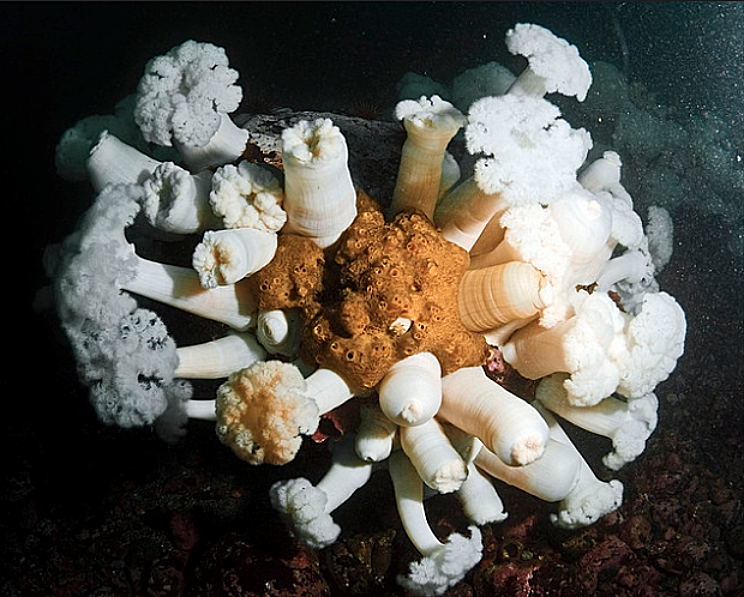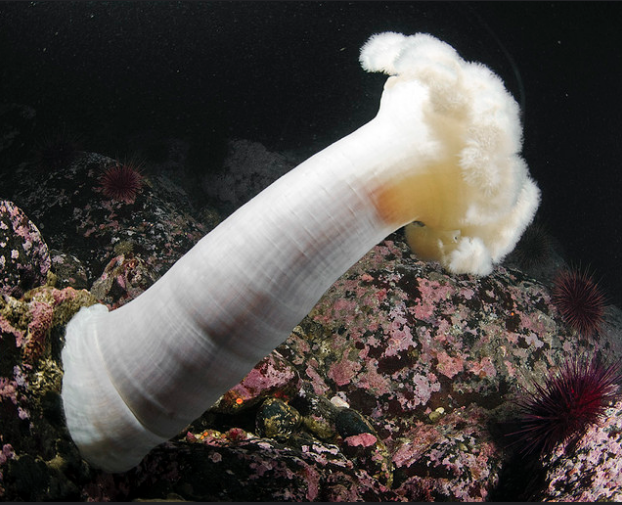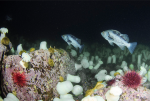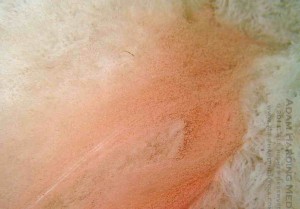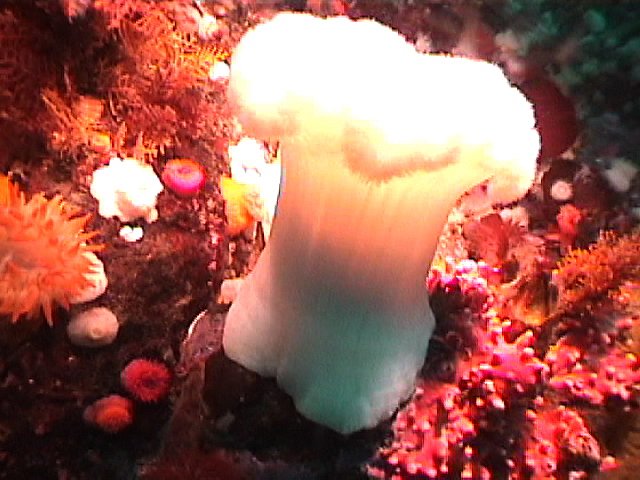General description: The Giant Plumose Anemone is a fairly large anemone of typically white, cream, tan, orange or brown colourations. Subtidal animals can often reach 25cm in crown diameter and 50cm in height. However larger specimens have been reported around 75cm in height. Shape of the column is much longer than wide. Tentacles lining the mouth of the oral disk are quite fine, very numerous, slender and short. Tentacle colouration is typically transparent when the tentacles are expanded and take the colour of the column when contracted.Habitat: Found in both subtidal and low intertidal zones, including jetties, wharfs, harbours, breakwaters and floats. When found on wharfs, anemone communities of dense distribution are common. Larger specimens are often found solitarily in the subtidal. The Plumose Anemone ranges from Alaska to southern California and along both sides of America.
These images by Ryan Murphy show the biological associations of which they are a part.
- Biodiversity and Metridium
- Sunstar and metridium
- Black Rockfish and Metridium
Feeding: Both the small and large anemones feed primarily on zooplankton, using their stinging tentacles to catch the prey. The feeding appears non-selective. Scraps of fish and squid and small benthic (subtidal) organisms are also taken.
In this video Ben from Australia introduces us to this abundant anemone found in the waters around Race Rocks. Note the fine tentacles– ideal for trapping plankton in the high current areas. Also note that this is not Metridium senile as labelled, but Metridium farcimen
Predators: The Plumose Anemone has few predators. Nudibranchs feed on small anemone, while in Puget Sound (Washington State) a sea star (Dermasterias imbricata) has been found to feed on larger anemones.
Reproduction: The anemone reproduces both asexually and sexually. Asexual reproduction occurs as the anemone moves about, leaving small sections of its pedal disk (base) behind, in a process described as pedal laceration. Dense colonies can be formed in this manner, with the pedal disks forming small cloned rounded anemones that feed and grow.
Sexual reproduction occurs in a broadcast spawning process whereby the males release sperm with wedged-shaped heads stimulating the females to release their eggs, about 0.1mm in diameter with a pinkish colouration. External fertilization occurs, with the zygote dividing to form a planula larva which swims in planktonic form. Adam Harding caught this process in action in July .
Planulae settle and metamorphose into young anemones.
Biotic Associations: Plumose Anemone symbiosis is an area in which little research has been done. Possible commensal behaviour may be similar to other anemones which have certain fish (e.g Clown Fish) which use the anemone.
Interesting behaviour: Anemones are rich in nematocysts (stinging cells) which are used in both defense and attack. The normal tentacles contain these cells used for both defense and feeding. However, in large colonies of Plumose Anemones the species bordering the colony develop a different type of tentacle; “catch” tentacles. These tentacles, which are used to repel non-cloned anemones, take about 9 weeks to develop close to the mouth and may number as great as 19 on an individual organism. If the “catch” tentacles, which contain a different type of nematocysts, touch another anenome from a separate colony a stinging tip breaks of and releases the separate complement of nematocysts. This technique is used to repel intruding anemones. Interestingly, these tentacles can expand to a possible length of 12cm.
| Domain | Eukarya |
| Kingdom | Animalia |
| Phylum | Cnidaria |
| Class | Anthozoa |
| Order | Actinaria |
| Family | Metridiidae |
| Genus | Metridium |
| Species | farcimen |
| Common Name: | Giant Plumose Anemone |
Reference: R.Morris, D.Abbott, E.Haderlie, Intertidal Invertebrates of California (690) pp. 62-63. Stanford University Press, Stanford, California. 1983.
Return to the Race Rocks Image Gallery and Taxonomy
|
|||||||||||

